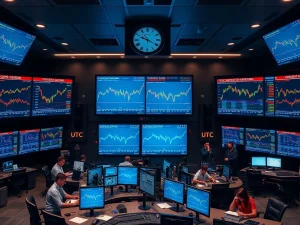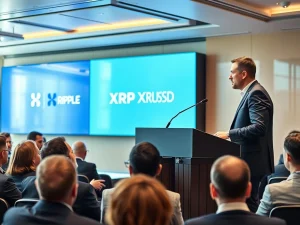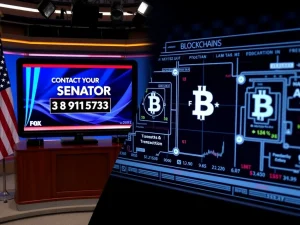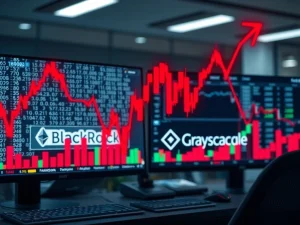Bitcoin Soars Past $119,000 as US-China Trade Truce Ignites Crypto Market Optimism

The cryptocurrency world is abuzz as Bitcoin recently demonstrated remarkable resilience and growth, surging past the $119,000 mark. This impressive climb is largely attributed to renewed optimism surrounding a potential de-escalation in US-China trade tensions, coupled with a notable uptick in institutional confidence. For anyone tracking the volatile yet rewarding digital asset space, understanding these intertwined dynamics is crucial. Let’s dive into what’s propelling Bitcoin’s latest rally and what it means for the broader crypto landscape.
Bitcoin Price: What’s Driving the Latest Surge?
Over the past weekend, Bitcoin (BTC) witnessed a significant upswing, hitting an intraday high of $119,700. This nearly 1% increase in just 24 hours, as reported by CoinMarketCap, was accompanied by a substantial 17% spike in trading volumes, reaching an impressive $56 billion. Currently trading around $119,326, Bitcoin sits just 2.88% shy of its all-time high of $123,091, recorded on July 13.
Several key factors appear to be converging to create this bullish momentum for the Bitcoin price:
Geopolitical Optimism: Reports suggesting a potential 90-day extension of the US-China tariff truce have significantly eased global market anxieties. Such a delay in tariffs could foster a more stable economic environment, which historically benefits risk assets like cryptocurrencies.
Institutional Endorsement: A notable ‘buy signal’ from MicroStrategy over the weekend reinforced confidence among institutional investors, signaling continued corporate interest in Bitcoin as a strategic asset.
Robust Network Health: The Bitcoin network’s hashrate reached a record 932 EH/s. This metric indicates a highly secure and resilient network, as it represents the total computational power being used to mine Bitcoin and process transactions. A high hashrate often translates to increased miner participation and network stability, bolstering investor trust.
US-China Trade Truce: A Catalyst for Crypto?
The geopolitical landscape plays an increasingly significant role in cryptocurrency valuations. The latest reports from the South China Morning Post, indicating that the U.S. and China plan to meet in Stockholm to finalize an agreement for another 90-day tariff pause, have sent ripples of optimism across global financial markets. This development is particularly impactful for the US-China trade relationship, and by extension, for the crypto market.
Analysts suggest that an extended tariff truce could:
Reduce Economic Uncertainty: Less trade friction typically leads to greater stability in traditional markets, which can free up capital for alternative investments.
Boost Investor Confidence: A more predictable global economic outlook encourages investors to take on more risk, making high-growth assets like cryptocurrencies more appealing.
Diversify Portfolios: In times of macroeconomic shifts, investors often look to assets like Bitcoin as a hedge or a diversifier against traditional market volatility.
The anticipation of eased trade tensions has created a favorable backdrop for Bitcoin’s recent surge, highlighting the growing interconnectedness between traditional macroeconomic factors and the digital asset space.
Institutional Interest and Network Health Fueling Confidence
The current rally isn’t just about external geopolitical factors; it’s also deeply rooted in the strengthening fundamentals of the cryptocurrency ecosystem. The renewed institutional interest, exemplified by MicroStrategy’s continued commitment to Bitcoin, serves as a powerful validation for the asset class. When major corporations publicly endorse and invest in Bitcoin, it often encourages other institutional players to follow suit, bringing in significant capital and legitimacy.
Furthermore, the record-high hashrate of 932 EH/s underscores the robust health and security of the Bitcoin network. This metric is crucial because it signifies the immense computational power dedicated to validating transactions and securing the blockchain. A higher hashrate means:
Enhanced Security: It becomes exponentially harder for malicious actors to compromise the network.
Miner Confidence: Miners are investing heavily in hardware and energy, indicating their long-term belief in Bitcoin’s profitability and stability.
Decentralization: A widely distributed and high hashrate reinforces the decentralized nature of the network, a core tenet of Bitcoin.
These internal strengths, combined with external market catalysts, paint a picture of a maturing asset class gaining traction among sophisticated investors.
Broader Crypto Market Reacts: Beyond Bitcoin
Bitcoin’s performance often acts as a bellwether for the entire digital asset ecosystem, and this rally is no exception. The broader crypto market has also experienced a significant uplift, with several altcoins reaching new milestones. The total cryptocurrency market capitalization is now nearing the formidable $4 trillion threshold, currently standing at $3.94 trillion.
Notable movements include:
Ethereum (ETH): The second-largest cryptocurrency surged above $3,825. CME futures for ETH also hit a record $7.85 billion in open interest, indicating strong institutional derivatives trading activity and growing confidence in Ethereum’s future.
Binance Coin (BNB): BNB, the native token of the Binance exchange, achieved a new all-time high of $825, reflecting robust platform usage and investor confidence in the Binance ecosystem.
These movements underscore the increasing correlation within the crypto market, where positive sentiment around Bitcoin often spills over into other major cryptocurrencies, driving overall market growth and investor enthusiasm.
Navigating Uncertainty: What to Watch in the Tariff Truce
While optimism abounds, analysts caution that the current rally is still somewhat speculative, particularly regarding the details of the anticipated Stockholm meeting. The absence of concrete terms from the reported tariff truce introduces a degree of uncertainty that market participants should closely monitor.
Key areas of caution include:
Timeline Deviations: Any delay or alteration from the reported 90-day extension could dampen market sentiment.
Terms of Agreement: The specifics of the agreement, once finalized, will be crucial. Unfavorable terms could lead to a quick reversal in risk asset prices, including cryptocurrencies.
Official Confirmation: Until an official joint statement from the U.S. and China confirms the truce details, the market remains susceptible to news-driven volatility.
Traders and investors are advised to remain vigilant, as Bitcoin’s proximity to its July high without a definitive breakthrough suggests a delicate balance between bullish sentiment and potential profit-taking. The asset’s inherent volatility means that real-time data and policy clarity will be paramount in determining its next significant move.
Conclusion: A Triumphant Surge Amid Global Shifts
Bitcoin’s recent surge past $119,000 is a compelling testament to its evolving role in the global financial landscape. Fueled by growing optimism over a potential US-China tariff truce and bolstered by strong institutional interest and network fundamentals, Bitcoin continues to demonstrate its potential as a high-reward asset. This rally not only highlights Bitcoin’s increasing integration into traditional finance but also underscores how macroeconomic factors and geopolitical developments are now integral to its price trajectory. While the current momentum aligns with a narrative of crypto as a portfolio diversifier, sustained growth will ultimately hinge on the resolution of key macro events and continued policy clarity. As the crypto market approaches the $4 trillion mark, participants are encouraged to stay informed and exercise caution, recognizing that volatility remains a defining characteristic of this dynamic asset class. The journey of Bitcoin continues to be an exciting blend of technological innovation and global economic interplay.
Frequently Asked Questions (FAQs)
Q1: What is driving Bitcoin’s recent price surge?
Bitcoin’s recent surge is primarily driven by renewed optimism surrounding a potential 90-day extension of the US-China tariff truce, which eases global market tensions. Additionally, increased institutional interest, exemplified by MicroStrategy’s buy signal, and a record-high network hashrate contributing to robust network security are significant factors.
Q2: How does the US-China tariff truce affect Bitcoin?
A potential US-China tariff truce is seen as a positive development for Bitcoin because it reduces global economic uncertainty. When traditional markets stabilize due to eased trade tensions, investors often become more confident in allocating capital to risk assets like cryptocurrencies, seeking higher returns or portfolio diversification.
Q3: What is institutional interest, and why is it important for Bitcoin?
Institutional interest refers to investment by large organizations like hedge funds, corporations (e.g., MicroStrategy), and asset managers. It’s important for Bitcoin because it brings significant capital, increases liquidity, and lends legitimacy to the asset class, signaling to other major players that Bitcoin is a viable and attractive investment.
Q4: What does a record hashrate mean for Bitcoin?
A record hashrate (e.g., 932 EH/s) indicates the total computational power dedicated to mining Bitcoin and securing its network. A higher hashrate means the network is more secure, as it becomes significantly harder for malicious actors to conduct attacks. It also reflects strong confidence from miners, who are investing heavily in the network’s long-term viability.
Q5: Is the current Bitcoin rally sustainable?
While the current rally shows strong momentum, analysts advise caution. Its sustainability largely depends on the concrete details and official confirmation of the US-China tariff truce. Any deviation from the reported timeline or terms, or unexpected macroeconomic shifts, could trigger a reversal in crypto prices. Monitoring diplomatic updates and broader economic data is crucial.










